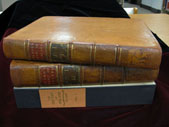About
This ghost story was written as an assignment for the UC Honors seminar, The Culture of Books and Reading, which dealt with the cross-cultural study of books and reading in world societies, and how ethnic, religious, and national cultures have regarded the printed word now and in the past. Looking at the form of the book from cuneiform to contemporary digital texts, the students learned about cultural approaches over time to sacred, secular, and political writings, as well as the technical and cultural contexts for contemporary reading habits from graphic novels to social media.
As part of this ethnological approach, they examined the values, purposes, and material expressions attached to books and libraries, and how a given culture or nation may relate to the culture of the world at large in these ways. So, this particular aspect of the course content included an experiential learning study tour to Edinburgh, Scotland from March 14-21, 2014. The beautiful city of Edinburgh was perfect because of its incredibly rich oral traditions, its literary heritage, and its vibrancy in contemporary reading habits that reflect global influences and changes. And, because Edinburgh was designated as the first UNESCO City of Literature in 2004, it made it even more of a key center for our seminar’s topics.
Scotland’s misty legacy of poets, legends, ghosts, and storytellers was perfect for this assignment. We delved into topics that have become an integral part of Edinburgh’s identity: its stature as the “Athens of the West” and its pre-eminence in medicine, literature, and the Enlightenment; the legacy of body-snatching and the serial killings of William Burke and William Hare in the 1820s; and its reputation as one of the most haunted cities in the world!
It was the heritage of ghosts and grave robbers that generated this assignment. I began with the title and the main characters, and recited the beginning of the story to my colleague, Robin Selzer. Robin then wrote the first page, and after we arrived in Edinburgh she passed it on to one of the students. From that point, each student wrote a page as the story was circulated and was completed before we left the city to return home to Cincinnati.
The rationale for this assignment was that books (and our reading of them) often derive initially from stories we tell each other, so our particular story is a reflection of how tales evolve into books and reading. Of course, each student had his or her own writing style, and took the story where a flight of fancy or insight guided the way. Beginning with the concept of the “sin-eater,” a societal role in many cultures and one in which an ostracized individual provides an important community role by absolving the dead of sins through a ritual meal. When a person dies and is laid out by the family, a meal of bread and ale, or other food, is placed next to the body. The sin-eater, shunned in everyday life, eats the meal, accepts a few coins perhaps, and then slinks back into a marginal place in the society. The sin-eater is one of life’s in-betweens. And, at one time, this custom was very real. It is believed that it was a role that dissipated in the early 20th century in Great Britain, and in Appalachia after World War II. Some death and dying practices remain forever, others change, and once-real customs become ritualized in new ways.
As one would expect, the students’ writing was informed by their itinerary in Scotland. Visits to the Surgeons’ Hall Museum and seeing the work of the early anatomists (along with William Burke’s death mask and a purse made of his skin after his hanging and dissection!), to Greyfriars Kirkyard, to underground vaults and the underground “city” of Mary King’s Close, as well as taking a ghost tour, all had a grand effect on what they wrote. I’ve done minor editing, evening out some syntax, some verb tenses, clarifying speakers in the story, and the like, but I’ve tried to leave the voice of each student. In a particular change, I substituted “Mr.” for “Doctor” in reference to the character Walter Wallace because, as we learned at the Surgeons’ Hall Museums, to distinguish themselves from the mere physicians who were called “Doctors,” surgeons maintained the title of “Mr.”
It is fitting that we “deposit” this story in the Archives & Rare Books Library as part of the Urban Studies Collection because in its generation and its essence, “The Sin-Eaters Ghost” is in every way a reflection of urban life and culture.
– Kevin Grace

